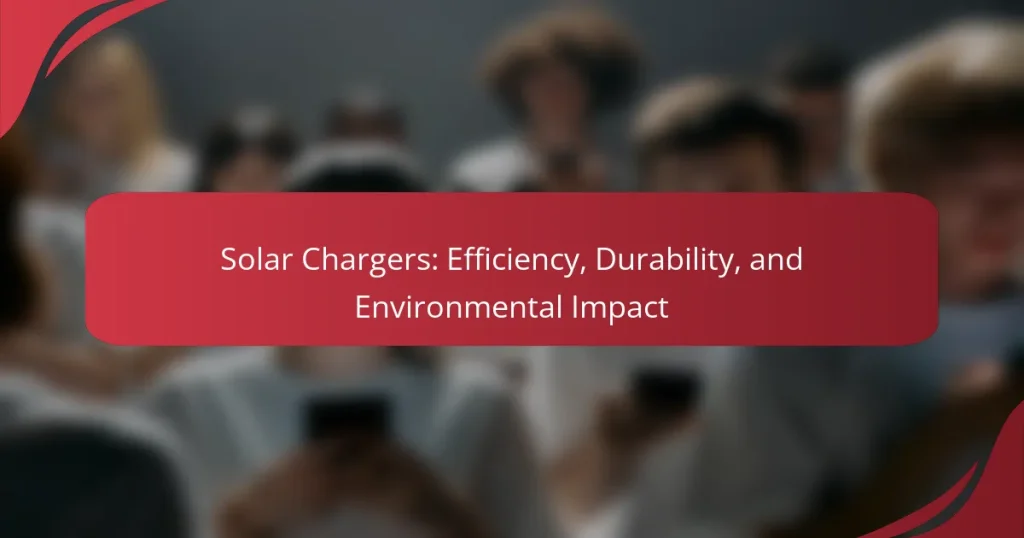Solar chargers are devices that convert sunlight into electrical energy using photovoltaic cells. This article examines the efficiency, durability, and environmental impact of solar chargers, highlighting their role as eco-friendly alternatives to traditional charging methods. Key topics include the technology behind solar chargers, their portability for outdoor activities like camping and hiking, and the variability in efficiency based on environmental conditions. Additionally, the article addresses how solar chargers can reduce reliance on fossil fuels, making them a sustainable choice for powering electronic devices.

What are Solar Chargers?
Solar chargers are devices that convert sunlight into electrical energy. They use photovoltaic cells to capture sunlight and generate electricity. This electricity can charge batteries or power electronic devices directly. Solar chargers are often portable and can be used in various settings. They are eco-friendly alternatives to traditional chargers. Solar chargers can significantly reduce reliance on fossil fuels. Many models are designed for outdoor use, making them ideal for camping or hiking. The efficiency of solar chargers can vary based on technology and environmental conditions.
How do Solar Chargers function?
Solar chargers function by converting sunlight into electrical energy. They utilize photovoltaic cells to capture sunlight. These cells generate direct current (DC) electricity when exposed to light. The DC electricity is then converted into usable power through a charge controller. This controller regulates the flow of electricity to prevent overcharging. The stored energy can be used to charge devices such as smartphones and tablets. Solar chargers are effective in sunny conditions, with efficiency rates typically ranging from 15% to 22%. Their functionality relies on the quality of the solar panels and environmental conditions.
What are the key components of Solar Chargers?
The key components of solar chargers include solar panels, charge controllers, batteries, and output ports. Solar panels convert sunlight into electricity through photovoltaic cells. Charge controllers regulate the voltage and current coming from the solar panels to prevent overcharging. Batteries store the generated energy for later use. Output ports allow users to connect devices for charging. Each component plays a crucial role in the overall functionality of solar chargers.
How do solar panels convert sunlight into electricity?
Solar panels convert sunlight into electricity through the photovoltaic effect. This process occurs when sunlight strikes the solar cells in the panels. The solar cells are made of semiconductor materials, typically silicon. When sunlight hits these materials, it excites electrons, creating an electric current. This current is then captured and directed for use as electricity. The efficiency of this conversion process can vary based on the type of solar cell and environmental conditions. Research shows that modern solar panels can achieve efficiencies of 15% to 22%.
What types of Solar Chargers are available?
Portable solar chargers are available in several types. These include foldable solar chargers, which are compact and easy to transport. There are also solar power banks, which store energy for later use. Another type is solar backpacks, featuring built-in solar panels for charging devices on the go. Additionally, there are solar phone chargers, designed specifically for smartphones. Some solar chargers are integrated into tents or other outdoor gear. Each type varies in efficiency and capacity, catering to different user needs. The versatility of these chargers makes them suitable for various outdoor activities.
What are the differences between portable and stationary Solar Chargers?
Portable solar chargers are designed for mobility and convenience. They are lightweight and compact, making them suitable for outdoor activities. Their power output is generally lower, typically ranging from 5 to 20 watts. This makes them ideal for charging small devices like smartphones and tablets.
Stationary solar chargers, on the other hand, are fixed installations. They have a larger surface area and higher power output, often exceeding 100 watts. This allows them to power larger devices or multiple devices simultaneously. Stationary chargers are usually installed on rooftops or in designated areas for optimal sun exposure.
The main difference lies in their intended use. Portable chargers are for on-the-go charging, while stationary chargers provide a more permanent energy solution. Their efficiency also varies, with stationary models generally performing better due to consistent sun exposure.
How do Solar Chargers vary in size and capacity?
Solar chargers vary significantly in size and capacity. Size can range from compact models designed for portability to larger panels for stationary use. Portable solar chargers typically measure around 10 to 20 inches in length. These smaller chargers often have lower power outputs, usually between 5 to 20 watts. Larger solar chargers, suitable for home or RV use, can exceed 40 inches and provide outputs from 50 to 200 watts.
Capacity, measured in watt-hours (Wh), also varies. Smaller chargers may store around 10,000 mAh, while larger systems can store over 100,000 mAh. This capacity influences the number of devices that can be charged simultaneously and the speed of charging. The efficiency of solar chargers can be affected by size and capacity, with larger units generally converting sunlight into electricity more effectively.
What factors influence the efficiency of Solar Chargers?
The efficiency of solar chargers is influenced by several key factors. These factors include the type of solar cells used, which determine how effectively sunlight is converted into electricity. Monocrystalline solar cells typically offer higher efficiency compared to polycrystalline cells.
The angle and orientation of the solar panel also play a crucial role. Panels positioned to maximize sunlight exposure throughout the day will generate more power. Additionally, environmental conditions such as temperature, shading, and weather can impact performance.
For example, high temperatures can reduce the efficiency of solar cells. Dust and debris on the panel surface can obstruct sunlight, further decreasing output. The quality of the charger’s components, including the inverter and battery, also affects overall efficiency.
Research indicates that solar chargers can achieve efficiencies ranging from 10% to over 20%, depending on these variables. Therefore, optimizing these factors is essential for maximizing the performance of solar chargers.
How does solar panel technology impact efficiency?
Solar panel technology significantly impacts efficiency by converting sunlight into electricity effectively. Advances in photovoltaic materials enhance energy conversion rates. For example, monocrystalline solar panels can achieve efficiencies above 20%. This means they convert over 20% of sunlight into usable energy. Additionally, innovations like bifacial panels capture sunlight from both sides, increasing overall output. Research shows that improved inverter technology also boosts system efficiency. These advancements enable solar systems to produce more energy in smaller spaces. Overall, the evolution of solar panel technology leads to higher efficiency and better energy yield.
What role does sunlight exposure play in charging efficiency?
Sunlight exposure significantly enhances charging efficiency in solar chargers. The intensity and duration of sunlight directly influence the amount of energy captured by solar panels. High-intensity sunlight allows for greater energy absorption, resulting in faster charging times. Solar panels convert sunlight into electricity through photovoltaic cells, which are most effective when exposed to direct sunlight. Studies show that solar chargers can achieve up to 20% efficiency under optimal sunlight conditions. Conversely, cloudy or indirect sunlight reduces energy capture, leading to slower charging rates. Therefore, maximizing sunlight exposure is crucial for optimizing the performance of solar charging systems.
How durable are Solar Chargers?
Solar chargers are generally designed to be durable and withstand various environmental conditions. Many models feature rugged materials such as reinforced plastic or aluminum casing. These materials enhance resistance to impacts and weather elements like rain and dust.
Typically, solar chargers are rated for outdoor use and can endure temperature fluctuations. Some high-quality solar chargers have an IP rating, indicating their level of water and dust resistance. For instance, an IP67 rating means the device can be submerged in water up to 1 meter for 30 minutes without damage.
In addition, manufacturers often provide warranties that range from 1 to 2 years, reflecting confidence in their durability. Research indicates that solar panels can last 25 years or more with proper care, which supports the longevity of solar chargers. Overall, the durability of solar chargers makes them reliable for outdoor activities and emergency situations.
What materials are commonly used in the construction of Solar Chargers?
Solar chargers are commonly constructed using materials such as photovoltaic (PV) cells, plastic, glass, and aluminum. Photovoltaic cells are the primary component that converts sunlight into electricity. These cells are typically made from silicon, which is known for its efficiency in energy conversion. The protective casing is often made from durable plastic to withstand environmental conditions. Glass is frequently used to cover the PV cells, providing protection while allowing sunlight to pass through. Aluminum is commonly utilized for the frame, offering strength and lightweight characteristics. These materials collectively ensure the efficiency and durability of solar chargers in various conditions.
How do environmental conditions affect the durability of Solar Chargers?
Environmental conditions significantly influence the durability of solar chargers. High temperatures can cause overheating, leading to reduced efficiency and potential damage to internal components. Conversely, extremely low temperatures can hinder performance and battery efficiency. Humidity and moisture exposure can lead to corrosion, affecting electrical connections and overall functionality. Dust and debris accumulation can obstruct solar panels, diminishing their ability to capture sunlight efficiently. UV radiation can degrade materials over time, impacting the longevity of the charger. Studies indicate that solar chargers designed for outdoor use incorporate protective features to enhance durability against these environmental factors.
What is the environmental impact of Solar Chargers?
Solar chargers have a positive environmental impact by reducing reliance on fossil fuels. They harness solar energy, which is renewable and abundant. This process decreases greenhouse gas emissions compared to traditional energy sources. According to the U.S. Department of Energy, solar energy systems can reduce carbon dioxide emissions by 80% over their lifetime. Additionally, solar chargers contribute to lower air pollution levels. They help mitigate climate change effects by promoting sustainable energy use. Overall, solar chargers support eco-friendly practices and contribute to a cleaner environment.
How do Solar Chargers contribute to reducing carbon footprints?
Solar chargers contribute to reducing carbon footprints by harnessing renewable energy from the sun. They convert sunlight into electricity, which can power devices without relying on fossil fuels. This process significantly lowers greenhouse gas emissions associated with traditional energy sources. For instance, using solar energy can reduce carbon dioxide emissions by up to 1,000 kg per year per household. Furthermore, solar chargers promote sustainable energy practices. They help decrease the demand for coal and natural gas, which are major contributors to climate change. By utilizing solar technology, individuals and businesses can actively participate in reducing their environmental impact.
What are the lifecycle environmental considerations for Solar Chargers?
Lifecycle environmental considerations for solar chargers include resource extraction, manufacturing processes, usage, and end-of-life disposal. Resource extraction involves mining materials like silicon and metals, which can lead to habitat destruction and pollution. Manufacturing processes consume energy and may release harmful emissions. During usage, solar chargers provide renewable energy, reducing reliance on fossil fuels and lowering greenhouse gas emissions. End-of-life disposal poses challenges, as improper disposal can lead to toxic waste. Recycling programs can mitigate these issues by recovering valuable materials. Studies indicate that life cycle assessments show solar chargers have a lower overall environmental impact compared to conventional chargers.
How can users maximize the performance of Solar Chargers?
Users can maximize the performance of solar chargers by ensuring optimal placement and angle. Positioning solar chargers in direct sunlight enhances energy absorption. An angle of 30 to 45 degrees typically yields the best results. Keeping the solar panels clean is essential for maintaining efficiency. Dust and debris can significantly reduce energy capture. Users should also avoid shading from trees or buildings. Shaded panels can drop efficiency by up to 80%. Additionally, using high-quality solar chargers with advanced technology can improve performance. Chargers with built-in smart technology can optimize energy conversion. Regularly checking connections and cables ensures a reliable power flow. Proper maintenance extends the lifespan of solar chargers and enhances their performance.
What best practices should be followed for optimal use of Solar Chargers?
To optimize the use of solar chargers, position them in direct sunlight. This maximizes energy absorption and charging efficiency. Ensure the solar panels are clean and free from debris. Dirt can significantly reduce their performance. Use the charger in optimal temperature conditions, ideally between 20°C to 25°C. Extreme temperatures can affect battery life and charging speed. Regularly check connections and cables for wear and tear. Damaged components can hinder charging efficiency. Store the solar charger in a dry place when not in use. Moisture can damage the internal components. Finally, monitor the battery’s charge level to prevent overcharging. Overcharging can shorten battery lifespan. Following these practices can enhance the longevity and functionality of solar chargers.
What common troubleshooting tips are available for Solar Chargers?
Check the solar panel for dirt or debris. Clean it with a soft cloth to ensure maximum sunlight absorption. Verify that the solar charger is placed in direct sunlight. Obstructions can significantly reduce charging efficiency. Inspect the connections and cables for damage or loose fittings. Damaged components can disrupt the flow of electricity. Ensure the device being charged is compatible with the solar charger. Incompatibility can prevent charging altogether. Monitor the battery level of the solar charger. A fully drained battery may take longer to recharge. If the solar charger has a built-in battery, check its health and replace it if necessary.
Solar chargers are devices that convert sunlight into electrical energy using photovoltaic cells, providing an eco-friendly alternative to traditional chargers. This article covers the functionality, key components, and various types of solar chargers, highlighting the differences between portable and stationary models. It also examines factors influencing efficiency, durability, and the environmental impact of solar chargers, including their role in reducing carbon footprints and lifecycle considerations. Additionally, best practices for maximizing performance and common troubleshooting tips are provided for users seeking to enhance their solar charging experience.


